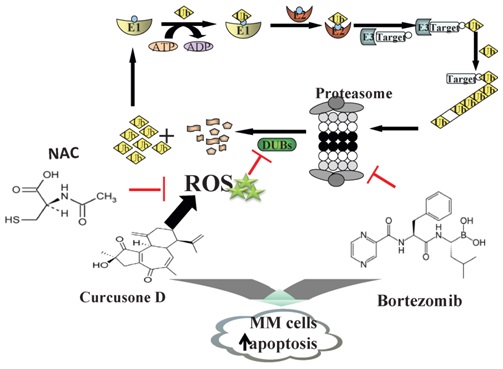
SIMM Identifies Novel Ubiquitin-proteasome Pathway Inhibitor Against Multiple Myeloma
Jul 24, 2014 Email"> PrintText Size

Targeting ubiquitin-proteasome pathway (UPP) is a promising strategy against multiple myeloma (MM). Researchers in LI Jia’ group at Shanghai Institute of Materia Medica (SIMM) reported that Curcusone D from Jatrophacurcas is a UPP inhibitor identified from the Ub-G76V-YFP reporter assay and has demonstrated potent cell growth inhibition and apoptosis in MM cell lines.
Curcusone D induced the accumulation of poly-ubiquitin conjugated proteins, but did not inhibit proteasome activity in vitro and in cells. Interestedly, the mono-ubiquitin level was significantly down-regulated by Curcusone D treatment. And the cellular DUBs activity was decreased significantly by Curcusone D which evidenced with reduced product release of fluorescence signal from the substrate of ubiquitin-Rhodamine110.
Next, the HA-Ubiquitin Vinyl Sulfone(HA-Ub-VS) Labeling experiment showed that many DUBs activity was blocked. Above results indicated that Curcusone D is a novel partially selective deubiquitinases (DUBs) inhibitor.
Recently, it has been reported that DUBs activity is sensitive to oxidative stress. Indeed, Curcusone D could significantly induce reactive oxygen species (ROS), which correlated closely with DUBs inhibition and cytotoxicity, which was completely blocked by the ROS scavenger N-acetyl-cysteine (NAC). Finally, the combination effect of Curcusone D and proteasome inhibitor Bortezomib was evaluated, and a strong synergistic effect on MM cells growth inhibition was observed.
The anti-MM molecular mechanism study of Curcusone D would help to improve to understand the anti-cancer effect of Jatrophacurcas, to approve the concept of oxidative stress regulating DUBs activity and to potentiate the combination therapies with different UPP inhibitors against MM.
This work has been published on Biochim et Biophys Acta-General Subjects (2014, 1840: 2004-2013), and was supported by the National Science and Technology Major Projects for “Major New Drugs Innovation and Development” (2012ZX09301001-004).

The mechanism of Curcusone D inhibiting ubiquitin-proteasome pathway and multiple myeloma (Image by SIMM)
Targeting ubiquitin-proteasome pathway (UPP) is a promising strategy against multiple myeloma (MM). Researchers in LI Jia’ group at Shanghai Institute of Materia Medica (SIMM) reported that Curcusone D from Jatrophacurcas is a UPP inhibitor identified from the Ub-G76V-YFP reporter assay and has demonstrated potent cell growth inhibition and apoptosis in MM cell lines.
Curcusone D induced the accumulation of poly-ubiquitin conjugated proteins, but did not inhibit proteasome activity in vitro and in cells. Interestedly, the mono-ubiquitin level was significantly down-regulated by Curcusone D treatment. And the cellular DUBs activity was decreased significantly by Curcusone D which evidenced with reduced product release of fluorescence signal from the substrate of ubiquitin-Rhodamine110.
Next, the HA-Ubiquitin Vinyl Sulfone(HA-Ub-VS) Labeling experiment showed that many DUBs activity was blocked. Above results indicated that Curcusone D is a novel partially selective deubiquitinases (DUBs) inhibitor.
Recently, it has been reported that DUBs activity is sensitive to oxidative stress. Indeed, Curcusone D could significantly induce reactive oxygen species (ROS), which correlated closely with DUBs inhibition and cytotoxicity, which was completely blocked by the ROS scavenger N-acetyl-cysteine (NAC). Finally, the combination effect of Curcusone D and proteasome inhibitor Bortezomib was evaluated, and a strong synergistic effect on MM cells growth inhibition was observed.
The anti-MM molecular mechanism study of Curcusone D would help to improve to understand the anti-cancer effect of Jatrophacurcas, to approve the concept of oxidative stress regulating DUBs activity and to potentiate the combination therapies with different UPP inhibitors against MM.
This work has been published on Biochim et Biophys Acta-General Subjects (2014, 1840: 2004-2013), and was supported by the National Science and Technology Major Projects for “Major New Drugs Innovation and Development” (2012ZX09301001-004).

The mechanism of Curcusone D inhibiting ubiquitin-proteasome pathway and multiple myeloma (Image by SIMM)
CAS Institutes
There are 124 Institutions directly under the CAS by the end of 2012, with 104 research institutes, five universities & supporting organizations, 12 management organizations that consist of the headquarters and branches, and three other units. Moreover, there are 25 legal entities affiliated and 22 CAS invested holding enterprisesThere are 124 I...>> more
Contact Us

Chinese Academy of Sciences
Add: 52 Sanlihe Rd., Xicheng District, Beijing, China
Postcode: 100864
Tel: 86-10-68597592 (day) 86-10-68597289 (night)
Fax: 86-10-68511095 (day) 86-10-68512458 (night)
E-mail: cas_en@cas.cn

